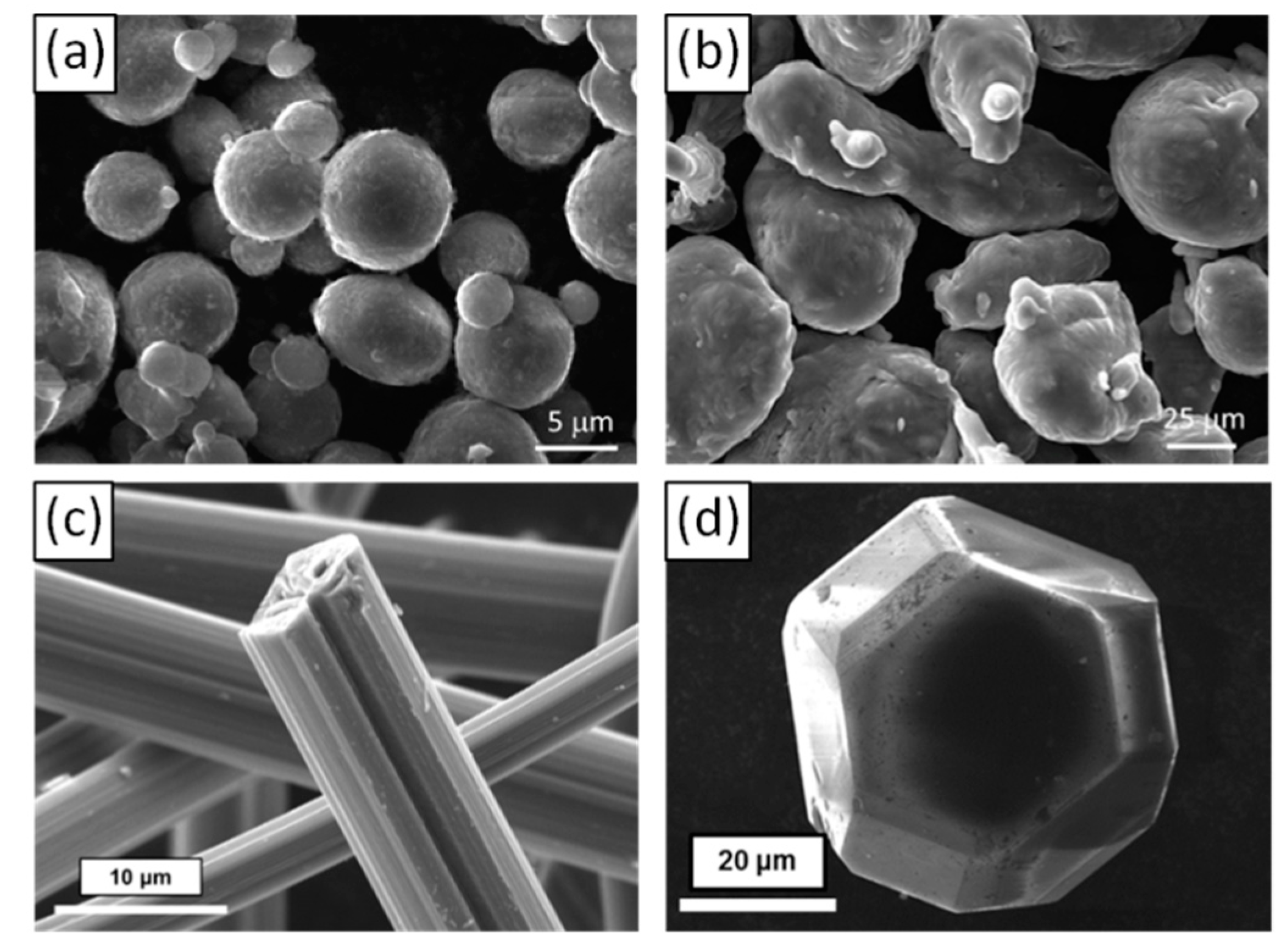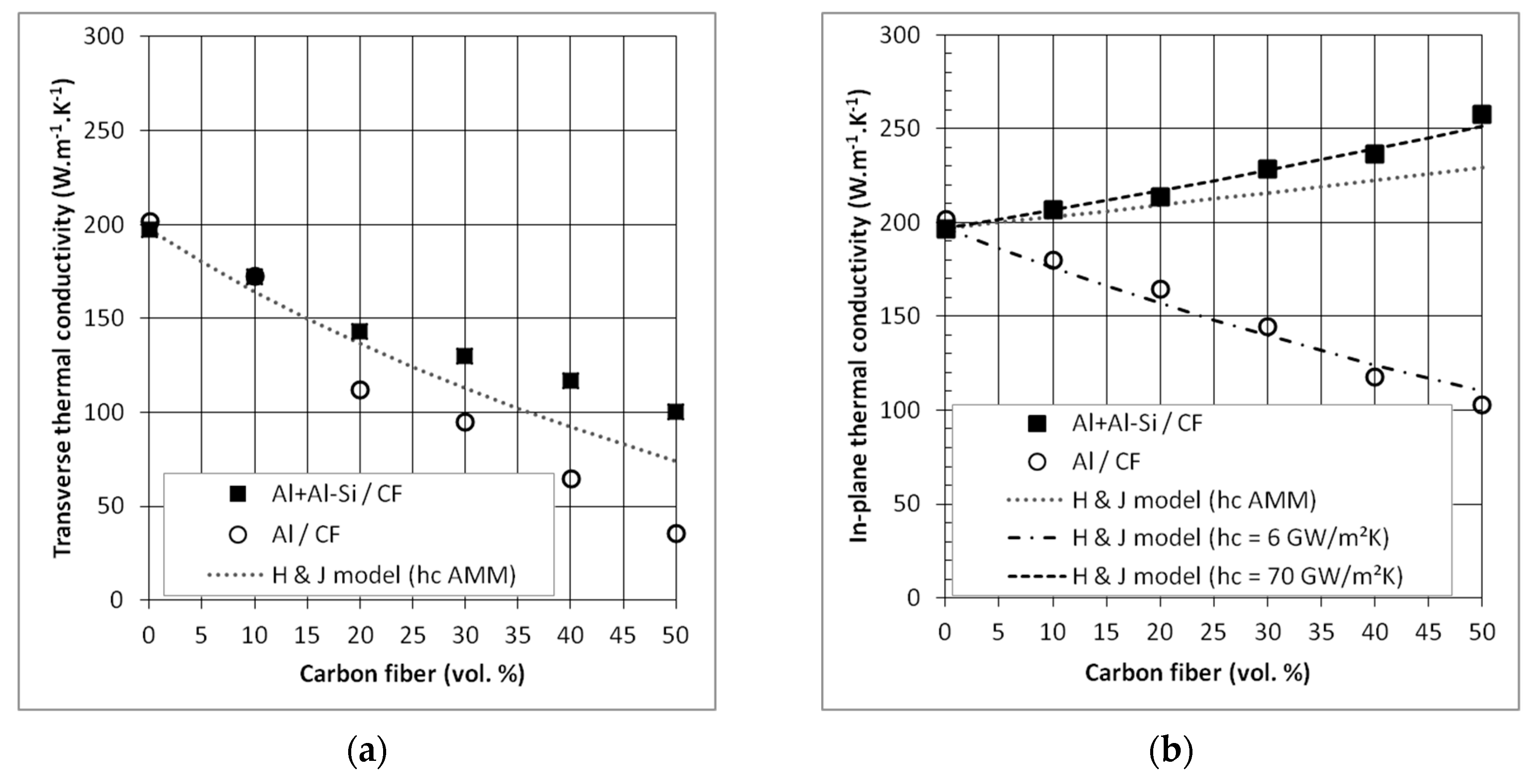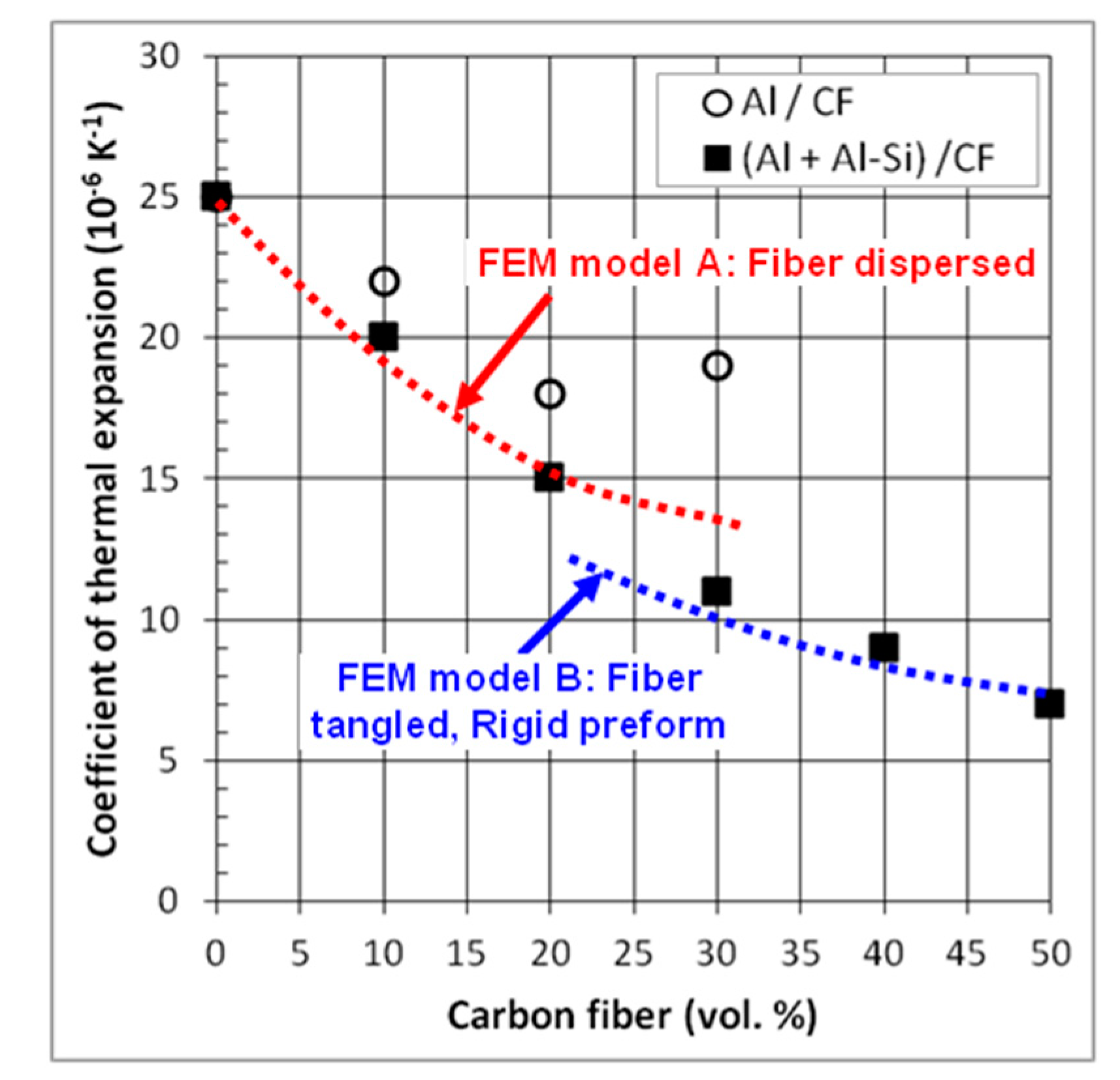Aluminum/Carbon Composites Materials Fabricated by the Powder Metallurgy Process
Abstract
:1. Introduction
2. Materials and Methods
2.1. Composite Materials
- Pitch-based carbon fibers (Raheama, R-A301, Teijin Limited, Chiyoda, Tokyo, Japan) with an average length of 200 µm, a diameter of 10 µm and a TC of 600 W·m−1·K−1 in the longitudinal fiber direction (Figure 1c).
- Single crystal diamond powders (MBD6 quality grade from Henan Zhongxin Industry, Henan, China) with hexagonal or cubo-octahedral shapes and an average diameter of 65 μm (Figure 1d).
2.2. Fabrication Process
- Set A: Al/C (CF or DP) composites fabricated without Al-Si powder and used as a reference.
- Set B: (Al + Al-Si)/C (CF or DP) composites fabricated with the addition of 5 vol.% of Al-Si powder.
2.3. Density, Microstructural, and Chemical Characterizations
2.4. Thermal and Thermomechanical Characterization
2.5. Theoretical Models
2.5.1. Thermal Conductivity Model
2.5.2. Coefficient of Thermal Expansion Models
3. Results and Discussion
3.1. Al/CF Composite Materials
3.1.1. Relative Density
3.1.2. Microstructure
- The presence of oxygen at the Al-CF interface (Figure 6—point B of the EDS spot) which is consistent with the alumina layer present on the surface of the Al powder particles before sintering.
- The presence of some dislocations inside the Al matrix and close to the Al-CF interface which can be attributed to the thermo-mechanical stresses induced by the difference of CTE between the CF and the Al matrix.
- A homogeneous distribution of the Si inside the Al matrix.
- A higher content of Si and O on the Al4C3 carbide particles (EDS map and EDS point A). This result is consistent with previous works using a squeeze-casting method to densify Al/Diamond composites material. It seems that the Al-Si eutectic phase segregates to the carbon reinforcement surface and participates in the Al/C bonding [10,20].
3.1.3. Thermal Conductivity
3.1.4. Coefficient of Thermal Expansion
3.2. Aluminum/Diamond Particle Composite Materials
3.2.1. Relative Density
3.2.2. Microstructure
3.2.3. Thermal Conductivity (TC)
3.2.4. Coefficient of Thermal Expansion (CTE)
4. Conclusions
- Liquid Al-Si phase contributed to decreasing the porosity ratio and optimizing the Al-C interfacial zone for both Al/CF and Al/DP composite materials.
- Si cluster and Al needle like carbide have been analyzed, by TEM, at the Al-CF interface for the Al/CF composite materials.
- Thermal conductivity and coefficient of thermal expansion appear to be strongly related to the composite density and the Al-C interfacial properties.
- Values of thermal conductivity of 258 W·m−1·K−1 and coefficient of thermal expansion of 7.0 × 10−6 K−1 were obtained for (Al + Al-Si)/CF composite with 50 vol.% of CF. These values satisfy the typical requirements for heat sink materials.
- Significant increase of the thermal conductivity (510 W·m−1·K−1) is obtained in the case of (Al + Al-Si)/DP composite materials with 50 vol.% of diamond particles. This thermal conductivity is coupled with a CTE of 10 × 10−6 K−1.
Author Contributions
Funding
Conflicts of Interest
References
- Luedtke, A. Thermal management materials for high-performance applications. Adv. Eng. Mater. 2004, 6, 142–144. [Google Scholar] [CrossRef]
- Mathias, J.-D.; Geffroy, P.-M.; Silvain, J.-F. Architectural optimization for microelectronic packaging. Appl. Therm. Eng. 2009, 29, 2391–2395. [Google Scholar] [CrossRef] [Green Version]
- Zweben, C. Advances in composite materials for thermal management in electronic packaging. JOM 1998, 50, 47–51. [Google Scholar] [CrossRef]
- Veillère, A.; Sundaramurthy, A.; Heintz, J.-M.; Douin, J.; Lahaye, M.; Chandra, N.; Enders, S.; Silvain, J.-F. Relationship between interphase chemistry and mechanical properties at the scale of micron in Cu–Cr/CF composite. Acta Mater. 2011, 59, 1445–1455. [Google Scholar] [CrossRef]
- Silvain, J.-F.; Veillère, A.; Lu, Y. Copper-Carbon and Aluminum-Carbon Composites Fabricated by Powder Metallurgy Processes. J. Phys. Conf. Ser. 2014, 525, 012015. [Google Scholar] [CrossRef] [Green Version]
- Lalet, G.; Kurita, H.; Heintz, J.-M.; Lacombe, G.; Kawasaki, A.; Silvain, J.-F. Thermal expansion coefficient and thermal fatigue of discontinuous carbon fiber-reinforced copper and aluminum matrix composites without interfacial chemical bond. J. Mater. Sci. 2014, 49, 397–402. [Google Scholar] [CrossRef]
- Kurita, H.; Kwon, H.; Kaxasaki, M.E.E.A. Multi-Walled Carbon Nanotube-Aluminum Matrix Composites Prepared by Combination of Hetero-Agglomeration Method, Spark Plasma Sintering and Hot Extrusion. Mater. Trans. 2011, 52, 1960–1965. [Google Scholar] [CrossRef] [Green Version]
- Vincent, C. Le Composite Cuivre/Nanofibre de Carbone. Ph.D. Thesis, Université de Bordeaux, Bordeaux, France, 2008. [Google Scholar]
- Veillere, A.; Heintz, J.-M.; Chandra, N.; Douin, J.; Lahaye, M.; Lalet, G.; Vincent, C.; Silvain, J.-F. Influence of the interface structure on the thermo-mechanical properties of Cu-X (X=Cr or B)/carbon fiber composite. Mater. Rese. Bull. 2011, 47, 375–380. [Google Scholar] [CrossRef]
- Beffort, O.; Khalid, F.; Weber, L.; Ruch, P.; Klotz, U.; Meier, S.; Kleiner, S. Interface formation in infiltrated Al(Si)/diamond composites. Diam. Relat. Mater. 2006, 15, 1250–1260. [Google Scholar] [CrossRef]
- Bird, R.B.; Stewart, W.E.; Lightfoot, E.N. Transport Phenomena, 2nd ed.; John Wiley and Sons: Hoboken, NJ, USA, 2006. [Google Scholar]
- Hasselman, D.; Johnson, L.F. Effective Thermal Conductivity of Composite with Interfacial Thermal Barrier Resistance. J. Compos. Mater. 1987, 21, 508–515. [Google Scholar] [CrossRef]
- Mizuuchi, K.; Inoue, K.; Agari, Y.; Sugioka, M.; Tanaka, M.; Takeuchi, T.; Tani, J.-I.; Kawahara, M.; Makino, Y.; Ito, M. Bimodal and monomodal diamond particle effect on the thermal properties of diamond-particle-dispersed Al–matrix composite fabricated by SPS. Microelectron. Reliab. 2014, 54, 2463–2470. [Google Scholar] [CrossRef]
- Battabyal, M.; Beffort, O.; Kleiner, S.; Vaucher, S.; Rohr, L. Heat transport across the metal–diamond interface. Diam. Relat. Mater. 2008, 17, 1438–1442. [Google Scholar] [CrossRef] [Green Version]
- Swartz, E.; Pohl, R. Thermal boundary resistance. Rev. Mod. Phys. 1989, 61, 605. [Google Scholar] [CrossRef]
- Kerner, E. The Elastic and Thermo-elastic Properties of Composite Media. Proc. Phys. Soc. Sect. B 1956, 69, 808–813. [Google Scholar] [CrossRef]
- Stoner, R.J.; Maris, H.J. Kapitza conductance and heat flow between solids at temperatures from 50 to 300K. Phys. Rev. B 1993, 48, 16373–16387. [Google Scholar] [CrossRef]
- Bosak, A.; Krisch, M. Elasticity of single-crystalline graphite: Inelastic x-ray scattering study. Phys. Rev. B 2007, 75, 153408. [Google Scholar] [CrossRef] [Green Version]
- Yuan, M.; Tan, Z.; Fan, G.; Xiong, D.-B.; Guo, Q.; Guo, C.; Li, Z.; Zhang, D. Theoretical modelling for interface design and thermal conductivity prediction in diamond/Cu composites. Diam. Relat. Mater. 2018, 81, 38–44. [Google Scholar] [CrossRef]
- Zhang, Y.; Li, J.; Zhao, L.; Zhang, H.; Wang, X. Effect of metalloid silicon addition on densification, microstructure and thermal–physical properties of Al/diamond composites consolidated by spark plasma sintering. Mater. Des. 2014, 63, 838–847. [Google Scholar] [CrossRef]
- Chamroune, N. Matériaux Composites Aluminium/Carbone: Architecture spécifique et propriétés Thermiques Adaptatives. Ph.D. Thesis, Université de Bordeaux, Bordeaux, France, 2018. [Google Scholar]
- Ueno, T.; Yoshioka, T.; Ogawa, J.; Ozoe, N.; Sato, K.; Yoshino, K. Hight thermal conductive metal/carbon composites by pulsed electric current sintering. Synth. Met. 2009, 159, 2170–2172. [Google Scholar] [CrossRef]
- Schapery, R. Thermal Expansion Coefficients of Composite Materials Based on Energy Principles. J. Compos. Mater. 1968, 2, 380–404. [Google Scholar] [CrossRef]
- Sideridis, E. Thermal expansion coefficients of fiber composites defined by the concept of the interphase. Compos. Sci. Technol. 1994, 51, 301–317. [Google Scholar] [CrossRef]
- Kurita, H.; Feuillet, E.; Guillemet, T.; Heintz, J.-M.; Kawasaki, A.; Silvain, J.-F. Simple Fabrication and Characterization of Discontinuous Carbon Fiber Reinforced Aluminum Matrix Composite for Lightweight Heat Sink Applications. Acta Metall. Sin. 2014, 27, 714–722. [Google Scholar] [CrossRef]












| Materials | Al | CF | DP | |
|---|---|---|---|---|
| Density (kg·m−3) | 2713 | 2260 | 3500 | |
| Specific heat (J·Kg−1·K−1) | 916 | 836 | 512 | |
| Size (µm) | Length | 50 | 200 | 65 |
| Diameter | 10 | |||
| Thermal conductivity (W·m−1·K−1) | Along axis | 197 | 600 | 1200 |
| Perpendicular to the axis | 10 | |||
| CTE (10−6 K−1) | Along axis | 23 | −1 | 1 |
| Perpendicular to the axis | 10 | |||
| Poisson ratio | 0.34 | - | - | |
| Phonon velocity (m·s−1) | 3620 | 14,660 | 13,430 | |
| Elastic modulus (GPa) | 71 | 760 | 1142 | |
| Shear modulus (GPa) | 26.6 | - | 535 | |
| Bulk modulus (GPa) | 68.55 | - | 442 | |
© 2019 by the authors. Licensee MDPI, Basel, Switzerland. This article is an open access article distributed under the terms and conditions of the Creative Commons Attribution (CC BY) license (http://creativecommons.org/licenses/by/4.0/).
Share and Cite
Veillère, A.; Kurita, H.; Kawasaki, A.; Lu, Y.; Heintz, J.-M.; Silvain, J.-F. Aluminum/Carbon Composites Materials Fabricated by the Powder Metallurgy Process. Materials 2019, 12, 4030. https://doi.org/10.3390/ma12244030
Veillère A, Kurita H, Kawasaki A, Lu Y, Heintz J-M, Silvain J-F. Aluminum/Carbon Composites Materials Fabricated by the Powder Metallurgy Process. Materials. 2019; 12(24):4030. https://doi.org/10.3390/ma12244030
Chicago/Turabian StyleVeillère, Amélie, Hiroki Kurita, Akira Kawasaki, Yongfeng Lu, Jean-Marc Heintz, and Jean-François Silvain. 2019. "Aluminum/Carbon Composites Materials Fabricated by the Powder Metallurgy Process" Materials 12, no. 24: 4030. https://doi.org/10.3390/ma12244030
APA StyleVeillère, A., Kurita, H., Kawasaki, A., Lu, Y., Heintz, J.-M., & Silvain, J.-F. (2019). Aluminum/Carbon Composites Materials Fabricated by the Powder Metallurgy Process. Materials, 12(24), 4030. https://doi.org/10.3390/ma12244030






